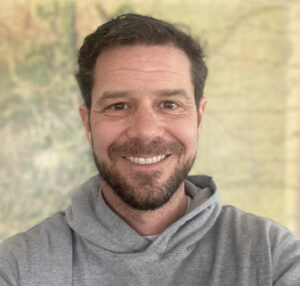The Bureau of Reclamation’s WaterSMART program includes a wide variety of funding opportunities for water efficiency, drought resilience, watershed management, and water reuse. Over the next 5 years, WaterSMART will disburse an additional $1.9 billion thanks to the Infrastructure Investment and Jobs Act, commonly known as the Bipartisan Infrastructure Law. In this interview, Josh German, the coordinator of WaterSMART Grants, and Dean Marrone, the manager of Reclamation’s Water Resources and Planning Office, give us the inside scoop on the different WaterSMART programs and provide advice to irrigation districts on how to put together a successful application.
Irrigation Leader: Please tell us about your backgrounds and how you came to be in your current positions.
Josh German: I have worked on WaterSMART programs since 2010. For the majority of that time, I have served as the program coordinator for WaterSMART Grants, a multimillion-dollar grant program focused on water conservation and sustainability.
Dean Marrone: I am the manager of Reclamation’s Water Resources and Planning Office. We coordinate WaterSMART by working with other Reclamation offices and collaborating with Reclamation’s partners, who propose and carry out projects. I’ve been with Reclamation for 17 years.
Irrigation Leader: Please give us a brief overview of WaterSMART.
Dean Marrone: Through WaterSMART, Reclamation works with states, tribes, irrigation districts, municipalities, nongovernmental organizations, and other local entities as they carry out actions to address water management challenges. The program includes a number of different categories of funding. Those include, among others, the WaterSMART Grants program, which supports improved water efficiency; the Drought Response Program, which provides assistance for drought planning and projects that build drought resilience; the Cooperative Watershed Management Program, which encourages diverse stakeholders to form local solutions to address their water management needs; and the Title XVI Water Reclamation and Reuse Program, which typically focuses on large water reuse projects across the West. WaterSMART also includes the Basin Study Program, which involves studies of the major river basins in the West, which are conducted by Reclamation and its partners, and funding for projects that use applied science to develop modeling and forecasting tools.
Irrigation Leader: Please give us a sense of the overall amounts of funding available through WaterSMART and the amount that an irrigation district might be able to secure for a particular project.
Dean Marrone: In fiscal year 2022, the total final appropriations for all WaterSMART programs was about $159 million. A large portion of that is for WaterSMART Grants, the Drought Response Program, and the Title XVI program. For each funding opportunity that’s made available to potential applicants, Reclamation lists the amount of funding that can be requested for a particular project. Under Water and Energy Efficiency Grants, for example, entities can now request up to $5 million, which is a higher limit than it’s been in the past. Previously, the most an entity could request for a project was $2 million in federal funding, with a nonfederal cost-share required alongside that. Reclamation’s implementation of the Bipartisan Infrastructure Law enables us to offer larger amounts of funding. That’s the case for Water and Energy Efficiency Grants; Drought Resiliency Projects; and a new category of funding, Environmental Water Resources Projects.
Irrigation Leader: Does Reclamation intend to maintain that higher upper limit of $5 million past this year?
Dean Marrone: Once applications have been received this summer, Reclamation will be assessing project sponsors’ level of interest in larger amounts of funding. But with higher amounts of funding available, it is likely that the maximum of $5 million per project will continue beyond this year. The Bipartisan Infrastructure Law includes $400 million over a 5‑year period for grants that include Water and Energy Efficiency Grants, Drought Resiliency Projects, Environmental Water Resources Projects, and others that Reclamation carries out under the authority of the SECURE Water Act. There’s also $100 million, again over 5 years, for Cooperative Watershed Management Program projects. The Bipartisan Infrastructure Law includes $550 million for water reuse projects under the existing Title XVI program and $450 million for a new category of funding for large-scale recycling and reuse projects with at least $500 million in total project costs that Reclamation is currently working to implement. And then there are others. There’s a new authority for multibenefit projects related to watershed health that’s getting $100 million as well. Each year, Reclamation’s spend plan will include an allocation of Bipartisan Infrastructure Law funding across the various categories that are included in that appropriation. For fiscal year 2022, Reclamation’s spend plan included $160 million of the $400 million for Water and Energy Efficiency Grants, drought projects, and similar projects.
Irrigation Leader: What cost-share amounts do the recipient entities generally have to contribute?
Dean Marrone: Reclamation is authorized to provide grant funding under the SECURE Water Act, which generally limits Reclamation to providing 50 percent of the cost of a project. Recent amendments to the SECURE Water Act allow applicants to request federal funding of up to 75 percent for projects that are expected to have environmental benefits. We’re implementing that through a new category of funding for Environmental Water Resources Projects. There are other exceptions. The Title XVI program, which is under a different authority, limits federal funding to 25 percent of the cost of a project. As I mentioned, those water reuse projects tend to be large, with total project costs of $100 million or more. Reclamation has worked to set up WaterSMART so that it fits with various types of projects being planned by water managers and works for various entities, including districts, municipalities, tribes, and others. For example, one category of funding for small-scale water efficiency projects is limited to no more than $100,000 per project with a 50 percent cost-share.
Irrigation Leader: WaterSMART grants cover a broad range of areas. Are there specific types of projects you focus on?
Dean Marrone: As Reclamation has developed WaterSMART over the years, the general approach has been to leave the project categories as open ended as possible, recognizing that we don’t know all the types of water management improvements that might be contemplated. The funding opportunities tend to list categories of projects without being prescriptive. Most of the funding opportunities don’t necessarily focus on a particular type of project. Water and Energy Efficiency Grants, for example, are open to lots of different types of projects, from canal lining or piping projects to the installation of automated gates. In the municipal setting, we fund things like the installation of residential water meters and turf replacement programs.
Josh German: Given how many different funding opportunities there are, sometimes entities have questions about which is the best fit for their particular project. There is a lot to navigate, and often it might not be entirely clear to a particular entity which is the right program to apply to. It’s always good to reach out to our staff. We’re available and happy to have that conversation.
Irrigation Leader: You mentioned the recycling and reuse program that Reclamation is currently developing. When is that going to get off the ground, and what’s that going to look like?
Dean Marrone: We are expecting to have draft program guidance available for public comment later this summer, with the first funding opportunities likely to follow this winter.
Irrigation Leader: What are some of the best ways for an irrigation district to make a successful application? How should they target their projects?
Josh German: First, they should familiarize themselves with the different aspects of WaterSMART and identify what program or programs may be a good fit. We have lots of resources about each program available on the website. Our staff is always available to talk through the options and provide guidance regarding a particular project or program. We also host webinars throughout the year. After we post a funding opportunity announcement, we usually do a webinar on that specific funding opportunity within a few weeks. I would encourage any entities that are thinking of applying to look at the latest information on the website and to reach out to our staff. Reclamation’s local area offices and regional offices can be a great resource as well.
Dean Marrone: On the WaterSMART website, there’s also an interactive map where potential applicants can see previously funded projects. You can go to the map, zoom in on a particular area, and click on the dots to get more information about each project that’s been funded. You can also see the applications that were successful in their funding requests. The requirements and the criteria change a little each year, but this can be a useful place to start to see the sorts of descriptions that applicants have given in the past and the way that they’ve responded to the selection criteria.
Irrigation Leader: Is there anything you’d like to add?
Josh German: The WaterSMART program has been successful because of stakeholder involvement. It’s encouraging to see that so many entities are interested in undertaking these different types of projects across the West. In just the last 2 years, for example, partners have been able to initiate 300 new projects through the program, including planning efforts to prepare for drought, the development of new tools, and on-the-ground projects that will help increase flexibility for water managers.
Josh German is the WaterSMART Grants coordinator at the Bureau of Reclamation. He can be contacted at jgerman@usbr.gov.

Dean Marrone is the manager of the Water Resources and Planning Office at the Bureau of Reclamation. He can be contacted at dmarrone@usbr.gov.

